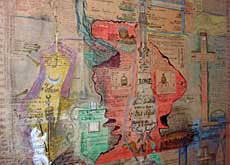A New World revealed by outsider artists

Two pictures by the founder of the Red Cross movement, Henry Dunant, are among some extraordinary works on display at an exhibition in Lausanne.
A sculpture made from the bones of cattle forms the centrepiece of the exhibition, devoted to works by “outsider artists” – recluses who were self-taught.
The two pictures by Dunant, recipient of the 1901 Nobel Peace Prize, will come as a surprise to many visitors. He created them during the last 22 years of his life, which he spent as a recluse before dying at the age of 82.
In fact it was those years of isolation which qualify Dunant for being among the featured artists, because all the works on view are by loners who also had at least two other things in common: they were self-taught and they were marginal characters, either patients in psychiatric clinics, prisoners, or simply eccentric and obsessive.
The exhibition is in a museum housing the world’s finest permanent collection of Art Brut, known in English as “outsider art”. This concept dates back to around 1945 although awareness of it began with research by psychiatrists in the early 20th century.
Art Brut
Art Brut embraces works in their raw state, immune from cultural and artistic influences. It’s even been said that the purest of Art Brut creators would not consider themselves artists, and nor would they feel that they were producing art at all.
However visitors to this exhibition, which ends on January 19, are left in little doubt that they are seeing art works of an extremely high standard.
It begins with a 67cm high sculpture by Francesco Toris (1863-1918) entitled “The New World” – also the title of the exhibition. An Italian policeman, Toris was admitted to the Turin Psychiatric Hospital when he was 33 and started work on this and other masterpieces.
“This is a classic example of outsider art,” museum curator Lucienne Peiry told swissinfo. “Toris was self-taught, never made preparatory sketches and created this labyrinth from cattle bones which he meticulously carved and sculpted.
“He slotted the bones together using neither nails nor glue, and the result is something fragile in every sense of the word, so delicate that its survival is incredible.”
Psychiatric care
For the exhibition, Peiry chose four other outsider artists whose works she wanted to “echo” the Toris sculptures. They include a leading figure in the world of Art Brut, Adolf Wölfli, who spent 30 years in a psychiatric clinic near Bern.
Another featured artist is Armand Schulthess (1901-1972). A Swiss civil servant, Schulthess became a dropout at 50, and went on to create a fantasy garden outside his rural home in Canton Ticino.
He painted numerous texts on such subjects as astrology, anatomy and philosophy on pieces of tin, and suspended them from the branches of trees. Examples of the painted texts are included in the exhibition alongside photographs of the artist in his garden.
Finally, much has been written about the humanitarian work of Henry Dunant, a Geneva businessman who founded the Red Cross after witnessing the terrible aftermath of the Battle of Solferino in 1859.
Recluse
But little is known about his final years as a recluse in Appenzell. Dunant turned his back on the outside world, devoted himself to prayer, studying the bible and reading books on geology, astronomy and the natural sciences.
In total seclusion, he also drew intricate coloured diagrams or sketches which, as Lucienne Peiry says, gave an apocalyptic dimension to his prophecies.
Peiry, whose book “Art Brut – the origins of outsider art” is published in English by Flammarion of Paris, was delighted to include two of Dunant’s art works alongside those of the other artists.
“Each artist creates his or her own style, technique and subjects without talking to anyone about his or her creation,” she said. “Each creator works in anonymity as though filling the pages of a diary.
“We can even say that the people to whom the art is addressed are absent from the artist’s mind, so there is a complete absence from the artist’s mind of any yearning for social and artistic recognition.”
swissinfo, Richard Dawson
All the works on view are by loners who were self-taught.
Awareness of “Art Brut” began with research by psychiatrists in the early 20th century.
Art Brut embraces works in their raw state, immune from cultural and artistic influences.
Henri Dunant spent the last 22 years of his life as a recluse, dying at the age of 82.
He founded the Red Cross after witnessing the terrible aftermath of the Battle of Solferino in 1859.

In compliance with the JTI standards
More: SWI swissinfo.ch certified by the Journalism Trust Initiative
You can find an overview of ongoing debates with our journalists here. Please join us!
If you want to start a conversation about a topic raised in this article or want to report factual errors, email us at english@swissinfo.ch.